
Berbers or the Berber peoples, also called by their endonym Amazigh or Imazighen, are a diverse grouping of distinct ethnic groups indigenous to North Africa who predate the arrival of Arabs in the Arab migrations to the Maghreb. Their main connections are identified by their usage of Berber languages, most of them mutually unintelligible, which are part of the Afroasiatic language family. They are indigenous to the Maghreb region of North Africa, where they live in scattered communities across parts of Morocco, Algeria, Libya, and to a lesser extent Tunisia, Mauritania, northern Mali and northern Niger. Smaller Berber communities are also found in Burkina Faso and Egypt's Siwa Oasis.
Moroccan music varies greatly between geographic regions and social groups. It is influenced by musical styles including Arab, Berber, Andalusi, Mediterranean, Saharan, West African, and others.
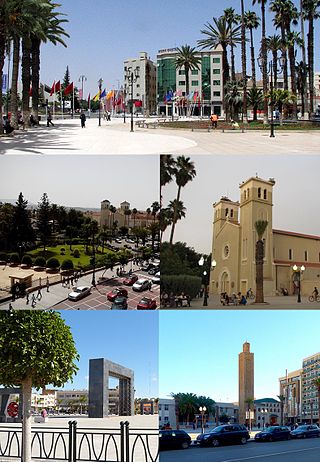
Oujda is a major Moroccan city in its northeast near the border with Algeria. Oujda is the capital city of the Oriental region of northeastern Morocco and has a population of 720,618 people. It is located about 15 kilometres west of the Moroccan-Algerian border in the south of the Beni Znassen Mountains and about 55 km south of the Mediterranean Sea coast.
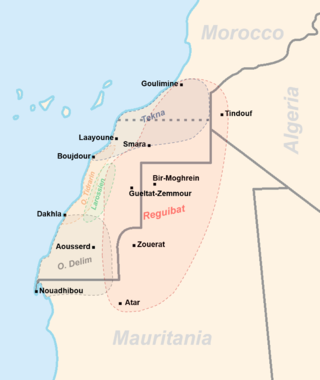
The Sahrawis, or Sahrawi people, are an ethnic group native to the western part of the Sahara desert, which includes the Western Sahara, southern Morocco, much of Mauritania, and along the southwestern border of Algeria. They are of mixed Hassani Arab and Sanhaji Berber descent, as well as West African and other indigenous populations.

MawlaySulayman bin Mohammed, born on 28 June 1766 in Tafilalt and died on 28 November 1822 in Marrakesh, was a Sultan of Morocco from 1792 to 1822, as a ruler of the 'Alawi dynasty. He was proclaimed sultan after the death of his half-brother al-Yazid. Sulayman continued his father's centralization and expansion of the kingdom, and most notably ended the piracy that had long operated from Morocco's coast. As part of Morocco's long running conflict with Spain and Portugal, Sulayman halted all trade with Europe. However, he continued his father's policies of close relations with the United States. He was also a follower of Wahhabism.
Berber music refers to the musical traditions of the Berbers, a diverse grouping of distinct ethnic groups indigenous to North Africa who predate the arrival of Arabs in the Arab migration to the Maghreb. Their main connections are identified by their usage of the mostly mutually unintelligible Berber languages. Berber music varies widely across North Africa. It is stylistically diverse, with songs being predominantly African rhythms and a stock of oral literature.
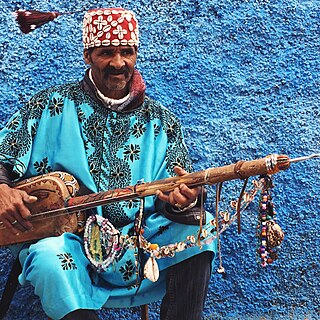
Gnawa music is a body of Moroccan religious songs and rhythms. Its well-preserved heritage combines ritual poetry with traditional music and dancing. The music is performed at lila, communal nights of celebration dedicated to prayer and healing guided by the Gnawa maalem, or master musician, and their group of musicians and dancers. Though many of the influences that formed this music can be traced to West African kingdoms, its traditional practice is concentrated in Morocco. Gnawa music has spread to many other countries in Africa and Europe, such as France.

Berkane is a city in northeastern Morocco, limited by the Mediterranean to the north, the Kis river and Oujda Province in the east, Nador Province to the west, and Taourirt Province in the south. It is the capital of Berkane Province.

Oriental région or Oujda region is one of the twelve regions of Morocco, located in the north-eastern part of the country. It covers an area of 90,127 km2 and has a population of 2,314,346 and is the easternmost region of Morocco.
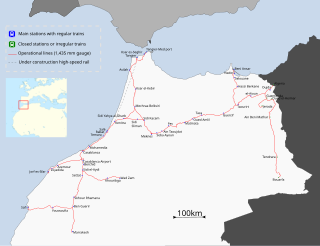
ONCF is Morocco's national railway operator. ONCF is a state-owned company that is under the control of the Ministry of Equipment, Transport and Logistics and is responsible for all passenger and freight traffic on the national railway network. The company is also responsible for building and maintaining the rail infrastructure.

Moroccans are the citizens and nationals of the Kingdom of Morocco. The country's population is predominantly composed of Arabs and Berbers (Amazigh). The term also applies more broadly to any people who are of Moroccan nationality, sharing a common culture and identity, as well as those who natively speak Moroccan Arabic or other languages of Morocco.

The BanuMa'qil is an Arab nomadic tribe that originated in South Arabia. The tribe emigrated to the Maghreb region of North Africa with the Banu Hilal and Banu Sulaym tribes in the 11th century. They mainly settled in and around the Saharan wolds and oases of Morocco; in Tafilalt, Wad Nun, Draa and Taourirt. With the Ma'qil being a Bedouin tribe that originated in the Arabian Peninsula, like Banu Hilal and Banu Sulaym, they adapted perfectly to the climatic desert conditions of the Maghreb, discovering the same way of life as in the Arabian Peninsula. The Ma'qil branch of Beni Hassan which came to dominate all of Mauritania, Western Sahara, south Morocco, and south-west Algeria, spread the Hassaniya Arabic dialect, which is very close to classical Arabic.
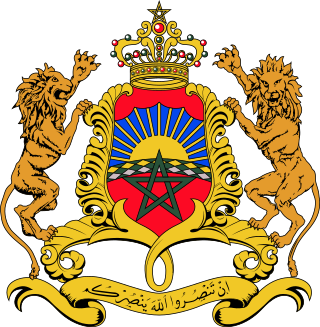
In Morocco, the 75 second-level administrative subdivisions are 13 prefectures and 62 provinces. They are subdivisions of the 12 regions of Morocco. Each prefecture or province is subdivided into arrondissements, municipalities or urban municipalities in other urban areas, and districts in rural areas. The districts are subdivided into rural municipalities. One prefecture (Casablanca) is also subdivided into préfectures d'arrondissements, similar to districts (cercles) except they are grouping a few arrondissements instead of rural municipalities.
Cap Radio is a private Moroccan radio station based in Tangier. It covers the audience basins of the western Rif ; the eastern Rif ; from the east and Sais. the region of Casablanca Settat and Marrakech allocate Tensift and the Moroccan Sahara it broadcasts its news items and programs in Moroccan Darija especially from the north and the Rif dialect.

Renaissance Sportive de Berkane commonly referred to as Nahdat Berkane or RS Berkane for short, is a Moroccan professional football club based in Berkane, that competes in Botola, the top flight of Moroccan football.

Berkane Province is located in northeastern Morocco in the Oriental region. It is bounded by the Mediterranean to its north, the Kiss Oued and Oujda Prefecture in the east, Nador Province to the west, and Taourirt Province in the south. The Berkane Province includes under its jurisdiction the towns of Saïdia and Ahfir. The population of the city is 80,012 as of the 2004 census. The population originates primarily from Aït Iznasen, a major tribe which consists of Berber clans. The tribe's descendants are spread widely over the rest of eastern Morocco, usually in cities like Ahfir, Saïdia and Oujda. The eastern dialect of Moroccan Arabic is spoken by most of the citizens, although Berber is still spoken by some of the adults.

The city of Nador in Morocco has two railway-stations: Nador Ville and Nador South. Further on the line there is also a station at Beni Anşār / Aït Nsar and the terminal Beni Anşār / Aït Nsar Port, which is generally indicated as Nador Port station. As with all railway stations in Morocco, these stations are operated by ONCF, Morocco's national railway operator.

Eastern Morocco Zenati dialects are a group of Berber dialects spoken in Morocco from Jerada Province to Berkane Province.

Oriental is one of the sixteen former regions of Morocco. It covers an area of 82,900 km2 and has a population of 1,918,094. The capital and largest city is Oujda, and the second largest city is Nador.

Ahidus, also sometimes called ahidous,haidous, tahidoust or hidoussi, is a Berber style of collective performance in Morocco. It is the traditional dance in many Berber tribes and is known to be the favorite entertainment of these tribes.
















